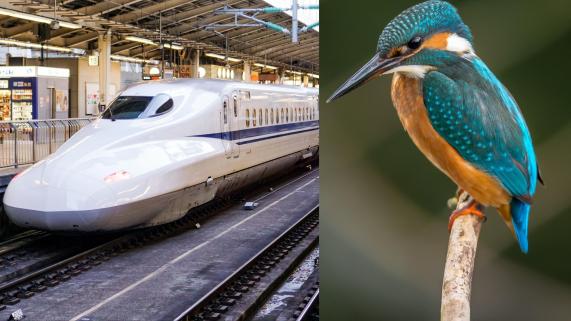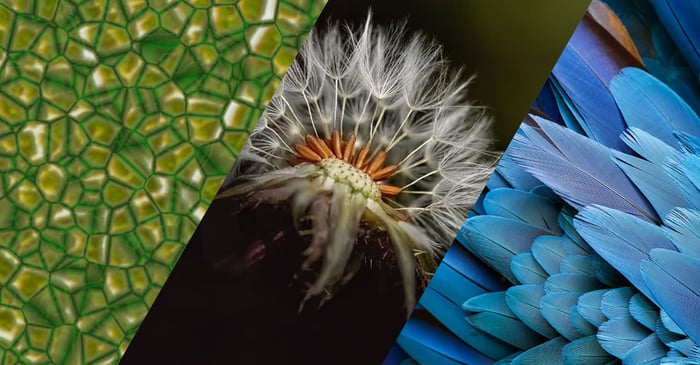'Bio' means living organism; 'mimicry' means to imitate. Biomimicry is thus the practice of imitating life and nature. Its aim is to draw inspiration from nature's engineering in order to solve the world’s most pressing challenges and ensure a sustainable future for all life on earth.
What is Biomimicry?
According to the Biomimicry Institute, biomimicry can be defined as “an approach to innovation that seeks sustainable solutions to human challenges by emulating nature’s time-tested patterns and strategies. The goal is to create products, processes, and policies—new ways of living—that are well-adapted to life on earth over the long haul.”
Biomimicry is a process based on the observation of our planet and its 3.8 billion years of evolution and development. Historically, biological organisms (animals, plants, microbes) have been able to develop strategies to survive, optimize their organization and functioning, and adapt their form to their function. As noted by the American biologist Janine Benyus, a renowned specialist in biomimicry: “Nature has already solved all the challenges we face. Failures have become fossils, and what surrounds us is the key to survival ”. Benyus was the first scientist to pioneer the notion of biomimicry in the late 1990s by developing the basic premise that human beings should consciously emulate nature's ways when looking for solutions to their problems, products and policies.
 The front end of the Shinkansen was re-designed to mimic the shape of a Kingfisher's beak. Image Credits: IIT Madras
The front end of the Shinkansen was re-designed to mimic the shape of a Kingfisher's beak. Image Credits: IIT Madras
Biomimicry is a technological-oriented approach focused on putting nature’s lessons into practice. For Janine Benyus, biomimicry sees nature as:
- A model. It studies nature’s systems and imitates them, using them as inspiration for designs or processes with the goal of solving human problems.
- A measure. It uses ecological standards to judge the rightness of human innovations.
- A mentor. A way of observing, assessing and valuing nature.
We have created scientific and technological achievements that have enhanced the human condition, but also disrupted the earth’s systems in extreme ways. As a result, today’s generation of researchers, designers and scientists are faced with pressing issues; their mission is to find solutions that do not add to the existing problems. As the name suggests, biomimicry aims to copy nature - not to deplete it. "Biomimicry is about valuing nature for what we can learn, not for what we can extract, harvest or domesticate" - Jane Benyus.
The concept of biomimicry is based on a key idea: nature always operates on the principles of economy and efficiency while generating no waste. As the famous French chemist, Antoine Lavoisier, said in 1774 “nothing is lost, nothing is created, everything is transformed”. No matter the field of application, the biomimetic philosophy is part of a global strategy of responsible and sustainable development that aims to balance the way the planet’s resources are used.
Examples of Biomimicry
- Climbing pads that support human weight are a mimic of the biomechanics of gecko feet.
- The aerodynamics of the Japanese bullet train was inspired by the shape of the Kingfisher's beak.
- The famous passive cooling buildings designed by Zimbabwean architect, Mick Pearce, were inspired by termite mounds.
- Velcro is born from observing the hooks implemented by some plants for the propagation of their seeds via animals' coats.
- The study of shark skin is behind some particularly effective swimming suits, as well as a varnish for plane fuselage.
 Image Credits : Biomimetic Design
Image Credits : Biomimetic Design
What is not Biomimicry
Biomimicry is one type of bio-inspired design, but not all bio-inspired design is biomimicry. An important factor that differentiates biomimicry from other bio-inspired design approaches is the emphasis on learning from and emulating the regenerative solutions living systems have for specific functional challenges. For example, biomorphism refers to designs that visually resemble elements from life (they “look like” nature), whereas biomimetic designs focus on function (they “work like” nature). The important difference here is looking at how nature operates.
Confusion also occurs between bio-utilization and biomimicry. The former refers to the use of biological material or living organisms in design or technology, e.g., using wood for furniture or a living wall of plants to help clean the air in an office building. Bio-utilization can be beneficial, and biomimetic designs sometimes incorporate it for this reason, however, just because a designer consults a living organism for a solution to a problem or uses a natural material, it does not mean the design is biomimetic.
"The distinctive feature of biomimicry is the study and emulation of functional strategies to create sustainable solutions that also embody the (re)connect and ethos elements" - Institute of Biomimicry.
3 essential elements of Biomimicry
When translating nature’s strategies into possible solutions, the science of biomimicry involves three essential elements: Emulate, Ethos, and (Re)Connect. These three components represent the core values that biomimicry is based on and aims to transmit in all its practices.
Emulate: The scientific, research-based practice of learning from and then replicating nature’s forms, processes and ecosystems to create more regenerative designs.
Ethos: The philosophy of understanding how life works and creating designs that continuously support and create outcomes conducive to life.
(Re)Connect: The concept that we are all part of nature and find value in acknowledging life’s interconnected systems. (Re)Connect as a practice encourages us to observe and spend time in nature, to understand how we are deeply connected to it, and to experience how life and its biological strategies works.
“I cannot help but feel a kinship with these trees now that I have spent years of my life trying to emulate them. In fact, I see all trees differently now.” - Alessandro Biancardi, Biomimicry Launchpad participant.
Biomimicry in agriculture and food packaging
Eating is our most intimate relationship with nature. Every time we take a bite of food there is an ecological, economic and social consequence. Food and all its associated activities – land use, crop production, and supply chain - currently account for over a quarter (26%) of global greenhouse gas emissions. And since the world's population is not shrinking, this impact will only grow.
Modern agricultural practices are enormously productive, but only in the short term. The irrigation, fertilizers and pesticides upon which modern food crops depend both deplete and pollute water supplies and essential soil resources. Scientists are increasingly turning to principles of biomimicry to find solutions to these agricultural problems. Here are some examples:
- Perennials: In order to revolutionise the foundations of modern agriculture, The Land Institute has been working on harnessing the powers of biomimicry by drawing inspiration from natural prairies as a model. They have managed to demonstrate that rather than using weedy crops common to many modern agricultural systems, the use of deep-rooted plants which survive year-to-year (perennials) in agricultural systems that mimic stable natural ecosystems can produce equivalent yields of grain whilst maintaining and improving the water and soil resources which the future agriculture depends on.
- Defense molecules: Every year 25% of total fruit and vegetable products are lost or wasted because of fungal spoilage. To combat this situation, various synthetic fungicides are commonly used, however, not only are these chemicals harmful but the fungi often develop resistance to these fungicides, making them ineffective over time. Research reveals that plants have developed methods to combat diseases by naturally producing volatile molecules (terpenoids, alkaloids, phenols) to protect themselves from many fungal diseases and also stimulate other plants in the environment to activate their defense system. Although these molecules are very effective, they are not active for more than a few minutes. Nanomik Biotechnology in Turkey have created a solution using customized encapsulation technology for these defense molecules. Immediately after application to crops in the field, these microcapsules attach to the surface of both plants and fungi and are released in a controlled manner. Their targeted micro-encapsulation system is applied in both pre-harvest and post-harvest applications and outperforms synthetic fungicides, all while treating a broad spectrum of fungal diseases without damaging human or planet health.
- Symbiotic fungi: In these climate-challenged times where agriculture is the biggest user of water, being able to grow crops with less water is the vital breakthrough many scientists are working towards. Microbiologist Dr Rusty Rodriguez had been studying how certain plants managed to grow in very arid conditions and became intrigued by a panicum grass found around the edges of the Yellowstone hot springs. He discovered that this grass has a 'fungal helper' which wraps itself around the roots creating a mycelial network that helps the grass to flourish. Rodriguez and his team of scientists have been able to prove that certain types of symbiotic fungi are capable of passing on specific benefits to plants including tolerance to drought, salt and temperature stress. Rice plants were inoculated with this fungus resulting in five time more rice being grown with half the usual amount of water. Rodriguez has gone on to form Symbiogenics and Adaptive Symbiotic Technologies to pursue solutions for a sustainable future in agricultural habitats and to apply symbiotic biomimicry technologies to agricultural problems by developing a series of seed and plant treatment products that confer symbiotic benefits to crop plants.
- Mushroom roots: Biomimicry has many implications for the plastic-dominated world of food packaging. Scientists and researchers have been developing solutions that emulate the qualities of natural packaging in order to protect food while maintaining properties such as color, taste and aroma, not generating waste and sharing nutritional facts. Once again, it's the magic of fungi that holds the answers. Mycelium hyphae refers to the root-like structures that extend out of fungi. It produces small molecules, then gently and with supreme precision assembles them into complex structures so small that they are invisible to the human eye. In brief, this fungus naturally has a structure-building capacity. Mixed with agricultural waste, mycelium becomes strong, lightweight, waterproof and easy to mould; similar to polystyrene foam, but totally biodegradable and cheap to produce. Not only is it being used successfully in food and bottle packaging but also in building work, furniture, and even fashion design. Small businesses and food producers can grow mycelium themselves in 'at-home' packs. Mushroom Packaging invites you to become a customer and a licencee of their "grown in 7 days" mix of mycelium and hemp hurds.

Image Credits: Mushroompackaging.com
The Biomimicry Institute supporting education and business
Despite drawing its inspiration from over 3 billion years of nature's evolution, biomimicry is still a relatively new emerging discipline. In the last 20 years it has spread through the design, engineering and sustainability communities, but the need to create methodologies of enquiry in more sectors continues. The bridge has to be extended between what many biologists know (e.g., the workings of a whale's heart, an organ that pumps thanks to 65,000 miles of arteries) and what architects, builders and entrepreneurs need to know. This is why Jane Benyus and her team at the Biomimicry Institute set up the website Asknature.org, a portal for all learners and educators to find out more about nature's intricate systems of survival based on 1700 featured biological strategies.
Since biomimicry is not a body of work that can be downloaded and studied in one sitting but is best learnt via practice and research, Benyus recently launched the Biomimicry Youth Design Challenge for middle and high school children and the Global Design Challenge for adult teams. These challenges call for design concepts addressing any issue(s) outlined by the Sustainable Development Goals. Successful teams define a concrete, well-researched area of focus for their design efforts and apply the core concepts and methods of biomimicry in developing a solution. Winning projects are those that go beyond familiar approaches by identifying unique leverage points for change, removing barriers to the adoption and spread of existing solutions, and/or clearly demonstrate how biomimicry can lead to new or more effective solutions.
With the aim of bringing some of these innovative projects to the real world in business terms, the Biomimicry Launchpad was subsequently established as an incubator program that helps early-stage entrepreneurs bring nature-inspired solutions to market. In the same way that entrepreneurs need to know more about how nature is the best teacher, experts in biomimicry need to understand how to harness the world of business in order to make their inventions workable and profitable. The Launchpad program features a virtual 10-week customer discovery and technology validation incubator that covers topics such as creating a business plan, understanding customer needs, articulating a value proposition and building a solid team.
Similarly, the Biomimicry Ray of Hope prize has been created to help start-ups cross the critical threshold in becoming viable businesses by amplifying visibility and providing them with equity-free funding. Great ideas need a business model and a prototype, the $100,000 prize money shines a light on the innovative, nature-inspired solutions that may otherwise go unnoticed because of lack of funding.
Biomimicry at EHL
In January 2021, the EHL Institute of Nutrition R&D was launched by Dr Inès Blal (Co-Director of the Institute), Patrick Ogheard (Co-Director) and Cyrille Lecossois (Manager). It is one of EHL’s applied research institutes and as such, its objective is to put EHL expertise at the service of applied research by offering a unique set of deliverables to its sponsors. The mission of the EHL Institute of Nutrition R&D is to develop cutting edge solutions in food and kitchen management for healthier food with a positive social and ecological impact. The three founders envision a multi-disciplinary approach bridging biomimicry, science, management and culinary expertise is critical to the future of nutrition and F&B solutions.
A Student Business Project (SBP) was recently mandated by the latest partnership between Nestlé Research and the EHL Institute of Nutrition R&D. The project consisted of formulating biomimicry-related solutions to problems within the culinary domain such as food coloration, food packaging and food waste.





